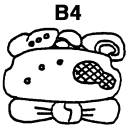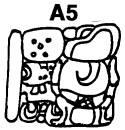

THE SUPPLEMENTARY AND LUNAR
GLYPHS
Sandwiched between the Tzolkin glyph block, here at A4, and the Haab glyph block at A7, are what is known as the SUPPLEMENTARY AND LUNAR GLYPHS; 8 of these were labeled by Morley as glyphs A, B, X, C, D, E, F and G (Teeple, 1930 p43); at some later time, two additional Lunar glyphs were found and added, Y and Z. All 10 of these glyphs need not appear in any particular inscription, and more than one glyphs is often conflated into one glyph block. The labeling of these Supplementary Glyphs is rather arbitrary, and there is some logic and convenience in grouping these by twos, and in this order: G and F, Z and Y, D and E,C and X,B and A. These 5 groups are recognized as Lords of Night, unknown, Moon Age, Lunation Number, Moon Type. (For historical completeness, the Mayanist Morgan, in 1915, working with the then known 7 Lunar Glyphs, labeled then A, B, C, D, E, F and G, and rearranged them backwards, in which order they still are (Schele, 1992, p56). The Supplementary and Lunar Glyphs begin to appear on Pre-Classic Maya recordings as early as 199 A.D. (08.07.19.10.19) (Justeson 198x, p79); this predates the appearance of the first Long Count Dates on Maya monuments.
THE LORDS OF THE NIGHT
 GLYPHS G and F
GLYPHS G and F
 GLYPHS Z and Y
GLYPHS Z and Y
GLYPHS D and E

Glyph
E, when present, adds 20 to the Moon Age value of Glyph D; on our example of
9.0.19.2.4, Glyph E is not present (Teeple 1930, p50, C Jones 1984, p60, Schele
1988, p54, T Jones, 1986, p14) or present (Coe, 1992, p131), the interpretation
depending on whether or not the moon element representing the value "20
days" is at Glyph Block B5. The "20 days" element is variedly
drawn as a complete moon sign with a dot or circle in the center (Thompson,
1960, p239), or the complete moon sign with three dots, sometimes at a diagonal
(T Jones, 1986, p14). Perhaps of crucial importance, to have a value increased
by 20, Glyph E must precede Glyph D. Glyph D will have a prefix value from
zero to 19; Moon Age values from 20 to 29 will have both Glyph E, meaning
"add 20 days", and Glyph D with an appropriate prefix. Stated another
way, for example "To record a moon age of 23 days,... the Lunar Series is
initiated by an "E" Glyph prefixed by a 3 and followed immediately by
the "D" Glyph ... the coefficient of "E" never exceeds 9 (T
& C Jones, 1993, p34).
THE MOON NUMBER
GLYPH C and X
Now,
eclipse prediction for a stone age culture, while significant and important, has
to be elusive. Consider that, while there is about an equal number of solar as
well as lunar eclipses, probably only about 1/3 of all eclipses are visible at
any one location on Earth, and that furthermore, of these, only one out of ten
will be solar. Not only that, but studies have shown that these few visible
eclipses do not show up at regular intervals, but rather tend to appear and
bunch up in groups (Smither, 1986, p99). The point that I would like to make is
that, like most other cultures, the Maya apparently attempted to link specific
lunations to eclipses for prediction purposes, and apparently were not always
successful.
What
we find is that sometimes different Maya City-States agreed on which lunation to
start counting the Moon Number from, and sometimes they did not. Teeple found
this out when he puzzled out the Moon Number. Previous to 9.12.15.0.0 (687
A.D.), differing Maya city-states had differing Moon Number Base, a period which
he calls, "of independence"; at about 9.12.15.0.0 a period of
agreement was reached, and all Maya City-States counted Moon Numbers from the
same base lunation, and furthermore, they all cycled through 6 lunations and
never 5; this is especially evident in at least the city-states of Piedras
Negras, Yaxchilán, Copán, Naranjo and Quiriguá (Teeple 1930, p54);
this he called the "Period of Uniformity". After 9.16.5.0.0
(765 A.D.), varying City-States, beginning with Copán, which began inserting an
occasional 5-lunations cycle (148 days) and which probably was the leading city
intellectually, gradually dropped out of uniformity, into a period known as the
"2nd change".
(Justeson
notes that an eclipse, Lunar or Solar, occurs somewhere every 176, 177 or 178
and occasionally 148 days, or every 6th and occasionally 5th lunation; the Saros
eclipse cycle follows the pattern 47 +41 +47 +41 +47 lunations; 47 is 7x6 + 1x5
lunations, and 41 is 6x6 + 1x5 lunations).
Justeson expounds on eclipse predictions (Justeson 198x, pp83-91), with
postulated lunation number, and the postulated last month of a moon number
beginning on a solar eclipse possibility; however, as enlightening as it is, its
too lengthy to present here.
Glyph
X, here recorded at the left half of Glyph Block B6, has been known to be
closely related to Glyph C, but no one knows its significance; note for instance
the skull which appears in both glyphs, over the hand in Glyph C, under the
crossed legs in Glyph X. Recently, Linda Schele made a breakthrough in
patterning the differing "X" glyphs (Schele, 1992, p58); the pattern
is that one of three elements: a skull, or a young moon goddess, or a jaguar,
co-varies with the Moon Number (the prefix of Glyph C). Aveni notes that often,
when the "crossed legs" appear in Glyph X, the prefix of C is 3 (Aveni,
1980, p165).
THE MOON TYPE GLYPH
GLYPH B and A
Glyph
B, when present, identifies or names the 29 or 30 day lunation; Schele calls
Glyph B its "Sprout Name" (the "Sprout Name" of Glyph A); in
our example, Glyph B is not present.
In
summary, we can see that Glyphs E/D, C, A, these representing Moon Age, Moon
Number and Moon Type, show a fairly sophisticated way to express a Lunar
Calendar; perhaps in the future, we will be able to prove or disprove that their
lunar calendar was also rigorously tied to eclipse predictions. In general,
while the accuracy of this calendar is one expected from the observational data
of a stone age culture, we have no problems using modern methods to authenticate
the basic correctness of at least the Moon Age values. We can also see that the
ancient Maya managed to mesh their exact day count with the lunar calendar for
some two thousand years (today, there are still Maya Calendar Keepers in remote
villages of the Yucatan Peninsula). As exemplified by over 170 Maya
inscriptions, the date almost always show the calendric order of "LONG
COUNT", "TZOLKIN",
"LORDS OF THE NIGHT", "LUNAR
GLYPHS F - Z - Y - E/D - C
- X - B - A", and "HAAB'.
Go
to Top
Return to Lunar Series Main Page
 Beam
Back to Astra's Main Page
Beam
Back to Astra's Main Page